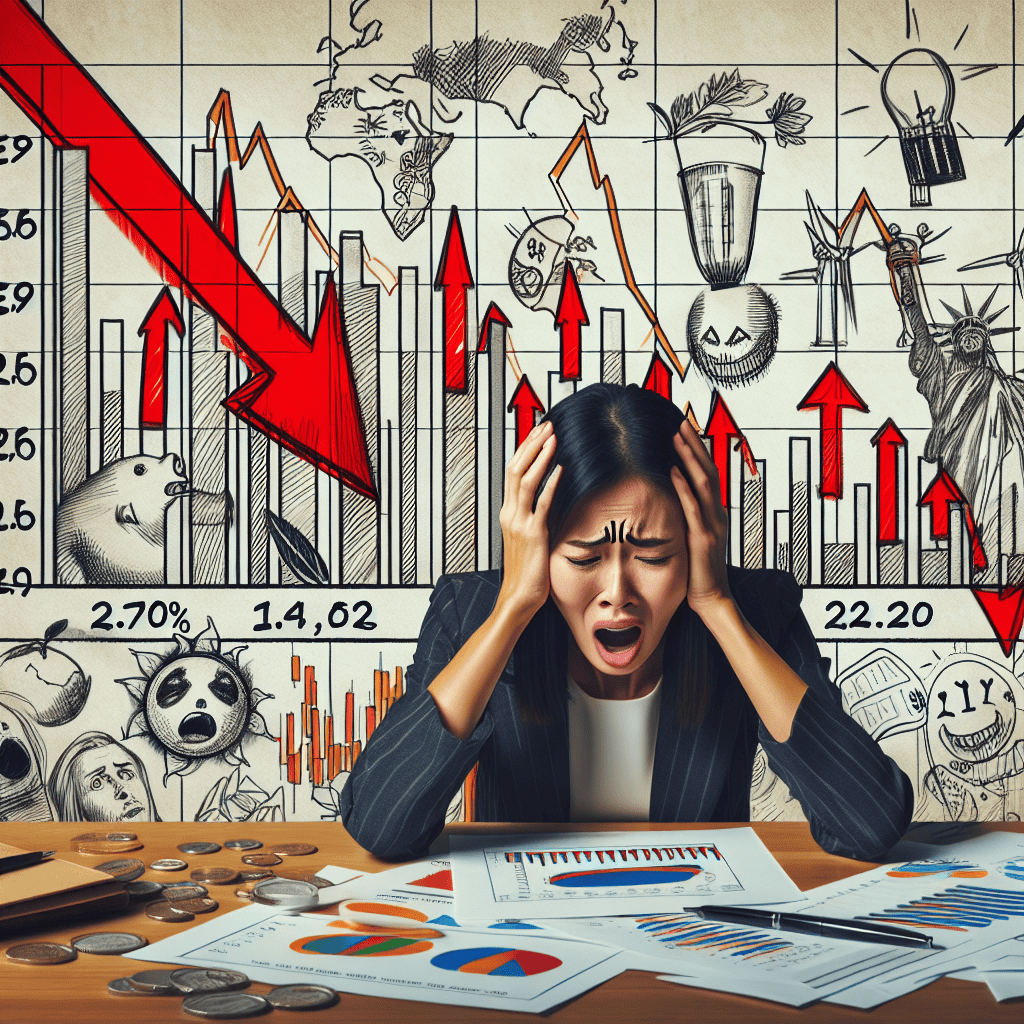“Market Shock: Green Energy Stocks Tumble Amidst Trump’s Win”
Introduction
Following the unexpected victory of Donald Trump in the 2016 U.S. presidential election, green energy stocks experienced a significant downturn. Investors reacted swiftly to the election results, driven by concerns over Trump’s campaign promises to revive the coal industry, withdraw from the Paris Agreement, and roll back environmental regulations. These policy positions starkly contrasted with the previous administration’s support for renewable energy initiatives, leading to uncertainty about the future of the green energy sector. As a result, stocks in solar, wind, and other renewable energy companies saw a marked decline, reflecting investor apprehension about the potential shift in federal energy policy and its implications for the growth and profitability of the green energy market.
Impact Of Political Changes On Green Energy Stocks
The recent election victory of Donald Trump has sent ripples through the financial markets, particularly impacting the green energy sector. As investors grapple with the potential policy shifts under a Trump administration, green energy stocks have experienced a significant downturn. This development underscores the profound influence political changes can have on market dynamics, especially in sectors heavily reliant on government support and regulation.
In the wake of Trump’s election, the stock market witnessed a notable shift in investor sentiment. While some sectors, such as fossil fuels and traditional energy, have seen a surge in optimism, green energy stocks have not fared as well. The decline in these stocks can be attributed to the anticipated policy changes that Trump, known for his skepticism towards climate change and renewable energy, might implement. His campaign promises included rolling back environmental regulations and withdrawing from international climate agreements, which have raised concerns about the future of government incentives and support for renewable energy projects.
Moreover, the uncertainty surrounding the regulatory environment has led investors to reassess the risk associated with green energy investments. The potential for reduced subsidies and tax incentives, which have been crucial in driving the growth of renewable energy, has made investors wary. This apprehension is reflected in the declining stock prices of companies involved in solar, wind, and other renewable energy technologies. The market’s reaction highlights the dependency of the green energy sector on favorable government policies, which have historically played a pivotal role in its expansion.
Furthermore, the broader implications of Trump’s victory extend beyond domestic policy changes. Internationally, the United States’ commitment to global climate initiatives is now in question. The potential withdrawal from agreements such as the Paris Accord could undermine global efforts to combat climate change and diminish the momentum of the green energy movement worldwide. This geopolitical shift adds another layer of complexity for investors, who must now consider the long-term viability of their investments in a potentially less supportive global environment.
Despite these challenges, it is important to recognize that the green energy sector is not without resilience. Technological advancements and decreasing costs have made renewable energy increasingly competitive with traditional energy sources. This intrinsic value may provide a buffer against political headwinds, as market forces continue to drive the adoption of cleaner energy solutions. Additionally, state and local governments, as well as private sector initiatives, may continue to champion renewable energy, providing alternative avenues of support.
In conclusion, the election of Donald Trump has undeniably impacted green energy stocks, reflecting the market’s anticipation of policy shifts that could alter the landscape for renewable energy. While the immediate reaction has been negative, the long-term outlook for green energy remains contingent on a complex interplay of political, economic, and technological factors. Investors and industry stakeholders will need to navigate this evolving landscape with caution, balancing the risks and opportunities that arise from political changes. As the world continues to grapple with the challenges of climate change, the role of government policy in shaping the future of green energy cannot be overstated, making it a critical area of focus for both investors and policymakers alike.
Market Reactions To Trump’s Energy Policies
The election of Donald Trump as President of the United States sent ripples through various sectors of the economy, with the green energy market experiencing a particularly significant impact. Investors in renewable energy stocks were met with a wave of uncertainty, leading to a sharp decline in stock prices. This reaction can be attributed to Trump’s campaign promises and subsequent policy proposals, which heavily favored traditional energy sources such as coal, oil, and natural gas over renewable alternatives like wind and solar power.
During his campaign, Trump consistently expressed skepticism about climate change and criticized the regulatory frameworks that supported the growth of the green energy sector. He pledged to dismantle the Clean Power Plan, withdraw from the Paris Agreement, and revive the coal industry, all of which signaled a potential rollback of federal support for renewable energy initiatives. Consequently, investors anticipated a shift in the energy landscape that could undermine the profitability and growth prospects of green energy companies.
In the immediate aftermath of Trump’s election victory, the stock market reflected these concerns. Major renewable energy companies saw their stock prices tumble as investors recalibrated their expectations in light of the anticipated policy changes. For instance, shares of leading solar companies experienced a notable decline, as did those of wind energy firms. This downturn was not limited to the United States; global markets also reacted, given the interconnected nature of the energy sector and the influence of U.S. policies on international markets.
Despite the initial panic, some analysts argue that the long-term outlook for green energy remains positive. They point to the decreasing costs of renewable technologies, which have made them increasingly competitive with fossil fuels. Additionally, many states and cities within the U.S. have committed to their own renewable energy targets, independent of federal policies. These subnational efforts, coupled with international commitments to reduce carbon emissions, suggest that the transition to a low-carbon economy may continue, albeit at a potentially slower pace.
Moreover, the private sector’s growing interest in sustainability and corporate responsibility could provide a counterbalance to federal policy shifts. Many corporations have set ambitious renewable energy goals and are investing in clean technologies to meet consumer demand and mitigate climate risks. This trend indicates that market forces, rather than government mandates alone, could drive the continued expansion of the green energy sector.
Nevertheless, the immediate market reaction underscores the significant influence of political leadership on investor sentiment and market dynamics. The uncertainty surrounding Trump’s energy policies has highlighted the vulnerability of the green energy sector to regulatory changes and the importance of stable policy environments for fostering investment and innovation. As the new administration’s policies unfold, stakeholders in the renewable energy market will need to navigate a complex landscape, balancing short-term challenges with long-term opportunities.
In conclusion, while Trump’s election victory initially led to a decline in green energy stocks, the broader trajectory of the sector will likely depend on a combination of technological advancements, market forces, and policy developments at various levels of government. As the world continues to grapple with the realities of climate change, the resilience and adaptability of the green energy market will be crucial in shaping a sustainable energy future.
Future Of Renewable Energy Investments Post-Election
The recent election victory of Donald Trump has sent ripples through the financial markets, particularly affecting the renewable energy sector. Green energy stocks have experienced a significant downturn, reflecting investor concerns about the future of renewable energy investments under a Trump administration. This development has raised questions about the long-term viability and growth prospects of the renewable energy industry, which has been gaining momentum over the past decade.
To understand the implications of this shift, it is essential to consider the policies and rhetoric that have characterized Trump’s campaign and early statements as President-elect. Trump has consistently expressed skepticism about climate change and has advocated for a resurgence of fossil fuels, including coal, oil, and natural gas. His promises to dismantle the Environmental Protection Agency’s regulations and withdraw from the Paris Agreement have further fueled uncertainty in the renewable energy market. Consequently, investors are reevaluating their positions, leading to a sell-off in green energy stocks.
Despite these immediate market reactions, it is crucial to recognize the broader trends that have been driving the growth of renewable energy. Over the past decade, technological advancements have significantly reduced the cost of solar and wind energy, making them increasingly competitive with traditional energy sources. Moreover, there is a growing global consensus on the need to transition to cleaner energy to combat climate change, with many countries committing to ambitious renewable energy targets. These factors suggest that, while the short-term outlook may be uncertain, the long-term trajectory for renewable energy remains positive.
Furthermore, it is important to consider the role of state and local governments in shaping energy policy. In the United States, many states have implemented their own renewable energy standards and incentives, independent of federal policy. States like California and New York have been at the forefront of promoting clean energy initiatives, and their continued commitment could mitigate some of the negative impacts of federal policy changes. Additionally, the private sector has shown a strong interest in renewable energy, with major corporations investing in clean energy projects to reduce their carbon footprint and meet sustainability goals.
In light of these factors, investors may need to adopt a more nuanced approach to renewable energy investments. While the immediate market reaction has been negative, the underlying fundamentals of the industry remain strong. Investors should consider the potential for continued technological innovation, the resilience of state-level policies, and the increasing demand for clean energy solutions from both consumers and businesses. By focusing on companies with strong fundamentals and a clear strategy for navigating the changing policy landscape, investors can position themselves to benefit from the long-term growth of the renewable energy sector.
In conclusion, while the election of Donald Trump has introduced uncertainty into the renewable energy market, it is important to maintain a balanced perspective. The short-term volatility in green energy stocks reflects immediate concerns about policy changes, but the broader trends driving the growth of renewable energy remain intact. By considering the interplay of federal, state, and private sector dynamics, investors can make informed decisions about the future of renewable energy investments. As the world continues to grapple with the challenges of climate change, the transition to a sustainable energy future is likely to persist, albeit with potential shifts in pace and focus.
Analyzing The Decline In Green Energy Stock Prices

The recent election victory of Donald Trump has sent ripples through various sectors of the economy, with the green energy industry experiencing a particularly significant impact. In the days following the election, green energy stocks have plummeted, raising concerns among investors and industry stakeholders. This decline can be attributed to several factors, primarily revolving around the anticipated policy shifts under the Trump administration. As the market grapples with uncertainty, it is crucial to analyze the underlying reasons for this downturn and its potential implications for the future of green energy.
To begin with, Trump’s campaign rhetoric and policy proposals have consistently emphasized a focus on traditional energy sources, such as coal, oil, and natural gas. This stance marks a stark contrast to the policies of the previous administration, which prioritized renewable energy development and environmental sustainability. Consequently, investors are apprehensive about the future of government support for green energy initiatives, which have historically relied on subsidies and tax incentives to remain competitive. The prospect of reduced federal backing has led to a sell-off in green energy stocks, as market participants reassess the sector’s growth potential.
Moreover, Trump’s skepticism towards climate change and his intention to withdraw from international agreements, such as the Paris Accord, further exacerbate concerns about the future regulatory environment. The potential rollback of environmental regulations could diminish the urgency for businesses to transition to cleaner energy sources, thereby dampening demand for renewable technologies. This anticipated policy shift has contributed to the bearish sentiment surrounding green energy stocks, as investors brace for a possible slowdown in the sector’s expansion.
In addition to policy concerns, the broader economic implications of Trump’s victory have also played a role in the decline of green energy stocks. The president-elect’s promises of tax cuts and increased infrastructure spending have fueled expectations of economic growth, which in turn have led to a rise in interest rates. Higher interest rates can increase the cost of capital for green energy projects, many of which require significant upfront investment. This potential increase in financing costs has added another layer of uncertainty for investors, further contributing to the sell-off.
Despite these challenges, it is important to recognize that the long-term outlook for green energy remains positive. The global shift towards renewable energy is driven by a combination of technological advancements, decreasing costs, and growing public awareness of environmental issues. While the U.S. may experience a temporary slowdown in green energy adoption, other countries continue to invest heavily in renewables, providing a buffer against domestic policy changes. Furthermore, many U.S. states and cities have committed to pursuing their own clean energy goals, independent of federal directives, which could help sustain momentum in the sector.
In conclusion, the decline in green energy stock prices following Trump’s election victory reflects a complex interplay of policy uncertainty, economic factors, and investor sentiment. While the immediate outlook may appear challenging, the fundamental drivers of the green energy transition remain intact. As the market adjusts to the new political landscape, stakeholders must remain vigilant and adaptive, seeking opportunities to navigate the evolving environment. Ultimately, the resilience of the green energy sector will depend on its ability to innovate and capitalize on the global demand for sustainable solutions.
Investor Sentiment Towards Green Energy Under Trump
The election of Donald Trump as President of the United States has sent ripples through various sectors of the economy, with the green energy industry experiencing a particularly significant impact. Investor sentiment towards green energy has shifted dramatically in the wake of Trump’s victory, leading to a notable decline in green energy stocks. This downturn can be attributed to several factors, including Trump’s campaign promises and his administration’s policy priorities, which have raised concerns about the future of renewable energy initiatives.
During his campaign, Trump made it clear that he prioritized traditional energy sources such as coal, oil, and natural gas over renewable energy. He frequently criticized the Obama administration’s environmental regulations and expressed skepticism about climate change, which he once famously referred to as a “hoax.” These statements have fueled apprehension among investors who fear that the new administration may roll back policies that have supported the growth of the green energy sector. Consequently, the uncertainty surrounding future government support for renewable energy has led to a sell-off in green energy stocks.
Moreover, Trump’s promise to withdraw the United States from the Paris Agreement has further exacerbated investor concerns. The Paris Agreement, a landmark international accord aimed at combating climate change, has been a driving force behind global efforts to reduce carbon emissions and transition to cleaner energy sources. The potential withdrawal of the U.S. from this agreement could undermine international cooperation on climate change and weaken the momentum for green energy investments. As a result, investors are wary of the long-term prospects for renewable energy companies, leading to a decline in their stock prices.
In addition to policy uncertainties, the market’s reaction can also be attributed to the broader economic implications of Trump’s proposed energy policies. By focusing on reviving the coal industry and expanding oil and gas production, the Trump administration may inadvertently create a more competitive environment for green energy companies. The increased supply of fossil fuels could lead to lower energy prices, making it more challenging for renewable energy sources to compete on cost. This potential shift in the energy market landscape has further dampened investor enthusiasm for green energy stocks.
Despite these challenges, it is important to note that the green energy sector is not without its strengths. Technological advancements and decreasing costs have made renewable energy sources such as solar and wind increasingly viable alternatives to fossil fuels. Additionally, many states and cities have committed to pursuing their own clean energy goals, independent of federal policies. These factors may provide some resilience to the green energy industry, even in the face of federal policy shifts.
Furthermore, global trends towards sustainability and environmental responsibility continue to drive demand for renewable energy. Countries around the world are investing in green technologies and infrastructure, recognizing the long-term benefits of reducing carbon emissions and mitigating climate change. This global momentum may help offset some of the negative impacts of U.S. policy changes on the green energy sector.
In conclusion, while the election of Donald Trump has led to a decline in green energy stocks due to investor concerns about future policy directions, the sector’s underlying strengths and global trends may offer some hope for recovery. As the new administration’s policies unfold, investors will be closely monitoring their implications for the renewable energy industry, weighing the risks and opportunities that lie ahead.
Comparing Green Energy And Fossil Fuel Stocks After The Election
The recent election victory of Donald Trump has sent ripples through the financial markets, particularly affecting the green energy sector. In the days following the election, green energy stocks have experienced a significant decline, raising concerns among investors and environmental advocates alike. This downturn can be attributed to the anticipated policy shifts under the Trump administration, which has historically favored fossil fuels over renewable energy sources. As investors brace for potential changes in regulatory frameworks and government support, the contrast between green energy and fossil fuel stocks has become increasingly pronounced.
In the wake of the election, green energy companies have faced a challenging environment. The uncertainty surrounding future government policies has led to a lack of confidence among investors, resulting in a sell-off of green energy stocks. Companies involved in solar, wind, and other renewable energy technologies have seen their stock prices drop, reflecting the market’s apprehension about the sector’s future growth prospects. This decline is particularly concerning given the global push towards sustainable energy solutions and the commitments made by various countries to reduce carbon emissions.
Conversely, fossil fuel stocks have experienced a resurgence, buoyed by the expectation of a more favorable regulatory environment under the Trump administration. The president-elect’s campaign promises to revive the coal industry and roll back environmental regulations have been met with enthusiasm by investors in traditional energy sectors. As a result, oil, gas, and coal companies have seen their stock prices rise, signaling a renewed confidence in the profitability of fossil fuels. This shift in investor sentiment highlights the stark contrast between the two sectors and underscores the potential impact of political leadership on market dynamics.
Moreover, the divergence between green energy and fossil fuel stocks is not solely a reflection of policy expectations but also indicative of broader market trends. The global energy landscape is undergoing a transformation, with technological advancements and changing consumer preferences driving a shift towards cleaner energy sources. However, the pace of this transition is heavily influenced by government policies and incentives, which can either accelerate or hinder the adoption of renewable technologies. In this context, the election outcome has introduced a degree of uncertainty that could slow the momentum of the green energy sector.
Despite the current challenges, it is important to recognize that the long-term outlook for green energy remains positive. The global commitment to addressing climate change and reducing reliance on fossil fuels is unlikely to wane, and technological innovations continue to make renewable energy more competitive. While the immediate impact of the election has been negative for green energy stocks, the sector’s underlying fundamentals remain strong. Investors with a long-term perspective may view the current downturn as an opportunity to invest in a sector poised for growth in the coming decades.
In conclusion, the election of Donald Trump has created a complex landscape for energy stocks, with green energy companies facing headwinds while fossil fuel stocks enjoy a resurgence. The contrasting fortunes of these sectors underscore the significant influence of political leadership on market dynamics and highlight the importance of government policies in shaping the future of energy. As the world continues to grapple with the challenges of climate change, the interplay between green energy and fossil fuels will remain a critical area of focus for investors and policymakers alike.
Strategies For Green Energy Companies In A Trump Administration
The election of Donald Trump as President of the United States sent shockwaves through various sectors, with the green energy industry experiencing a particularly significant impact. The immediate aftermath saw a sharp decline in green energy stocks, reflecting investor concerns over the future of renewable energy under an administration that has expressed skepticism about climate change and a preference for fossil fuels. In light of these developments, green energy companies must reassess their strategies to navigate the uncertain political landscape and ensure their continued growth and relevance.
To begin with, green energy companies should focus on diversifying their portfolios to mitigate risks associated with policy changes. By expanding their range of products and services, these companies can reduce their dependency on government incentives and subsidies, which may be at risk under a Trump administration. For instance, investing in energy storage technologies or energy efficiency solutions could provide alternative revenue streams and enhance the resilience of their business models. Additionally, exploring international markets where renewable energy policies remain favorable could offer new opportunities for growth and expansion.
Moreover, strengthening partnerships with private sector entities can provide green energy companies with a buffer against potential policy shifts. Collaborating with corporations that have committed to sustainability goals can create a stable demand for renewable energy solutions, independent of government policies. These partnerships can also foster innovation and drive down costs, making green energy more competitive with traditional energy sources. By aligning with businesses that prioritize environmental responsibility, green energy companies can reinforce their market position and continue to thrive despite political headwinds.
Furthermore, green energy companies should engage in proactive advocacy and public relations efforts to influence public opinion and policy. By effectively communicating the economic and environmental benefits of renewable energy, these companies can build broader support among the public and policymakers. Highlighting success stories, such as job creation in the renewable sector and the decreasing costs of solar and wind energy, can help counteract negative narratives and emphasize the sector’s potential to contribute to economic growth. Engaging with local communities and stakeholders can also foster grassroots support, which can be instrumental in shaping policy decisions at both state and federal levels.
In addition to advocacy, investing in research and development is crucial for maintaining a competitive edge. By advancing technological innovations, green energy companies can improve the efficiency and cost-effectiveness of their solutions, making them more attractive to consumers and businesses alike. Continued investment in R&D can also lead to breakthroughs that could redefine the energy landscape, positioning these companies as leaders in the transition to a sustainable future. Emphasizing innovation not only strengthens the industry’s value proposition but also demonstrates its commitment to addressing the challenges of climate change.
Finally, green energy companies should remain adaptable and responsive to changing market conditions. By closely monitoring policy developments and market trends, these companies can adjust their strategies accordingly to capitalize on emerging opportunities or mitigate potential risks. Flexibility and agility will be essential in navigating the complexities of a Trump administration, allowing green energy companies to remain resilient and forward-looking.
In conclusion, while the election of Donald Trump presents challenges for the green energy sector, it also offers an opportunity for companies to reassess and refine their strategies. By diversifying portfolios, building private sector partnerships, engaging in advocacy, investing in innovation, and maintaining adaptability, green energy companies can continue to thrive and contribute to a sustainable energy future, regardless of political uncertainties.
Q&A
1. **What happened to green energy stocks after Trump’s election victory?**
Green energy stocks experienced a significant decline following Trump’s election victory.
2. **Why did green energy stocks plummet after the election?**
Investors were concerned about Trump’s policies favoring fossil fuels and his skepticism towards climate change, which could negatively impact the renewable energy sector.
3. **Which sectors were most affected by the stock plummet?**
Solar and wind energy companies were among the most affected sectors.
4. **How did Trump’s victory impact investor sentiment towards green energy?**
Investor sentiment turned cautious or negative due to anticipated policy shifts away from renewable energy support.
5. **Were there any specific companies that saw a notable drop in stock prices?**
Companies like First Solar and SunPower saw notable declines in their stock prices.
6. **Did the broader stock market experience similar declines?**
No, the broader stock market did not experience similar declines; in fact, some sectors like fossil fuels saw gains.
7. **What were the long-term concerns for green energy companies post-election?**
Long-term concerns included potential rollbacks of environmental regulations and reduced government incentives for renewable energy projects.
Conclusion
The election of Donald Trump in 2016 led to a significant decline in green energy stocks, primarily due to market concerns about his administration’s potential policy shifts. Trump’s campaign promises included rolling back environmental regulations and promoting fossil fuel industries, which created uncertainty about the future of renewable energy investments. This uncertainty likely contributed to the plummet in green energy stocks, as investors anticipated reduced government support and incentives for renewable energy projects. The market reaction reflected fears that the growth trajectory of the green energy sector could be hindered by the new administration’s policy priorities.




